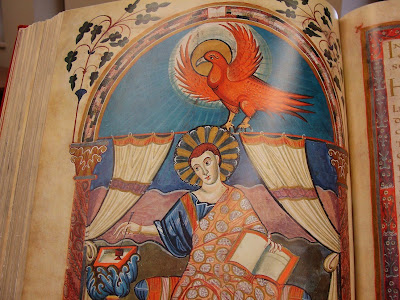March in Toronto.
Along with other parts of Canada and the United States, Toronto continues to face the effects of one of the harshest winters in recent memory. The above photo was taken from the solarium of Regis College this past Wednesday, a day on which Toronto received over ten centimetres of snow in a matter of hours. With temperatures below freezing expected to continue for the next several days, signs of a spring thaw remain elusive.

While I continue to look forward to spring, my studies provide a degree of distraction from the fierce winter weather. Lately, I have been spending a lot of time in the library of the Pontifical Institute of Mediaeval Studies, doing work for a course on medieval liturgy. The PIMS Library is the home to one of North America's largest and best collections of materials related to the Middle Ages, including many original manuscripts and other rare books. The PIMS Library provides a bright and quiet place to work, and, since its books cannot be checked out or otherwise removed from the library, researchers can be fairly certain that materials from the collection are available when they need them. Through the kindness of Father Leonard Boyle, O.P., a former PIMS faculty member who went on to serve as prefect of the Bibliotheca Apostolica Vaticana, the PIMS Library also possesses an impressive collection of microfilm and facsimile copies of medieval manuscripts held by the Vatican, many identified by the telltale stamp visible in the above photo.

One of the books I've been working with at PIMS is a facsimile edition of the Codex Aureus Laurensius or Lorsch Gospels, a richly illuminated Gospel Book produced in Aachen during the reign of Charlemagne. The book takes its name from the Benedictine Abbey of Lorsch, where the manuscript was kept from the ninth century until the time of the Reformation, when the abbey was dissolved and its splendid library was broken up. Divided into two volumes - an apt symbol, perhaps, of the fate of the library from which the book came - the Lorsch Gospels were split up and passed through various hands; the first volume ultimately ended up in Romania and the second came to rest in the Vatican Library, while the ivory panels from the front cover of the book eventually found their way to the Victoria and Albert Museum in London. The separated elements of the Lorsch Gospels were briefly reunited in 1965, when their respective owners allowed them to be displayed in Aachen and to be photographed for a facsimile edition. Thanks to this tangled history, the facsimile edition of the Lorsch Gospels includes the rather unique page of acknowledgments seen above, on which Pope Paul VI and the Communist government of Nicolae Ceaușescu are thanked for their mutual cooperation.

To bring some color to a generally monochromatic winter post, here is a photograph of one of the illustrated pages of the Lorsch Gospels. In the manuscript, this depiction of St. John the Evangelist serves to introduce the gospel bearing his name. For the opportunity to browse a digital copy of the Lorsch Gospels and to inspect more images like this one, you can find both volumes of the manuscript in the virtual library of the Bibliotheca Laureshamensis, an online project which seeks to recreate the vanished library of the Abbey of Lorsch by bringing together digital reproductions of all of the library's surviving manuscripts. For readers who share my interest in such things, I hope that this window into the distant past provides a bit of light and warmth during a dark, cold winter. AMDG.


2 Comments:
Their glow shine some light on this late winter gloom. I enjoy looking at art from the Middle Ages. There is such humanity and humour in them.
Thank you indeed, for some color to improve the view from desk (of mostly unrelieved grey - sky, bare trees, the room...), and for the link to the virtual text.
Post a Comment
<< Home